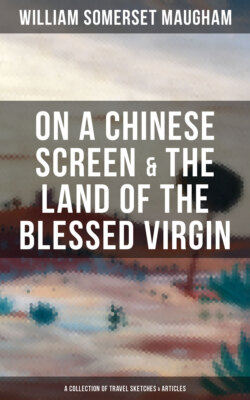Читать книгу On a Chinese Screen & The Land of the Blessed Virgin (A Collection of Travel Sketches & Articles) - Уильям Сомерсет Моэм - Страница 23
На сайте Литреса книга снята с продажи.
XIX The Giralda
ОглавлениеTable of Contents
The Christian bells rang joyfully from the Moorish tower, the great old bells christened with holy oil, el Cantor the Singer, la Gorda the Great, San Miguel. I climbed the winding passage till I came to the terrace where stood the ringers, and as they pulled their ropes the bells swung round on their axles, completing a circle, with deafening clamour. The din was terrific, so that the solid masonry appeared to shake, and I felt the vibrations of the surrounding air. It was a strange sensation to shout as loud as possible and hear no sound issue from my mouth.
The Giralda, with its Moorish base and its Christian belfry, is a symbol of Andalusia. There is in the Ayuntamiento an old picture of the Minaret built by Djâbir the Moor, nearly one hundred feet shorter than the completed tower, but surmounted by a battlemented platform on which are huge brazen balls and an iron standard. These were overthrown by an earthquake, and later, when the discoveries of Christopher Columbus had poured unmeasured riches into Seville, the Chapter commissioned Hernan Ruiz to add a belfry to the Moorish base. Hernan Ruiz nearly ruined the mosque at Cordova, but here he was entirely successful. Indeed it is extraordinary that the two parts should be joined in such admirable harmony. It is impossible to give in words an idea of the slender grace of the Giralda, it does not look a thing of bricks and mortar, it is so straight and light that it reminds one vaguely of some beautiful human thing. The great height is astonishing, there is no buttress or projection to break the very long straight line as it rises, with a kind of breathless speed, to the belfry platform. And then the renaissance building begins, ascending still more, a sort of filigree work, excessively rich, and elegant beyond all praise. It is surmounted by a female figure of bronze, representing Faith and veering with every breeze, and the artist has surrounded his work with the motto: Nomen Domini Fortissima Turris.
But the older portion gains another charm from the Moorish windows that pierce it, one above the other, with horseshoe arches; and from the arabesque network with which the upper part is diapered, a brick trellis-work against the brick walls, of the most graceful and delicate intricacy. The Giralda is almost toylike in the daintiness of its decoration. Notwithstanding its great size it is a masterpiece of exquisite proportion. At night it stands out with strong lines against the bespangled sky, and the lights of the watchers give it a magic appearance of some lacelike tower of imagination; but on high festivals it is lit with countless lamps, and then, as Richard Ford puts it, hangs from the dark vault of heaven like a brilliant chandelier.
I looked down at Seville from above. A Spanish town wears always its most picturesque appearance thus seen, but it is never different; the patios glaring with whitewash, the roofs of brown and yellow tiles, and the narrow streets, winding in unexpected directions, narrower than ever from such a height and dark with shade, so that they seem black rivulets gliding stealthily through the whiteness. Looking at a northern city from a tall church tower all things are confused with one another, the slate roofs join together till it is like a huge uneven sea of grey; but in Seville the atmosphere is so limpid, the colour so brilliant, that every house is clearly separated from its neighbour, and sometimes there appears to be between them a preternatural distinctness. Each stands independently of any other; you might suppose yourself in a strange city of the Arabian Nights where a great population lived in houses crowded together, but invisibly, so that each person fancied himself in isolation.
Immediately below was the Cathedral and to remind you of Cordova, the Court of Oranges; but here was no sunny restfulness, nor old-world quiet. The Court is gloomy and dark, and the trim rows of orange-trees contrast oddly with the grey stone of the Cathedral, its huge porches, and the flamboyant exuberance of its decoration. The sun never shines in it and no fruit splash the dark foliage with gold. You do not think of the generations of priests who have wandered in it on the summer evenings, basking away their peaceful lives in the sunshine; but rather of the busy merchants who met there in the old days when it was still the exchange of Seville, before the Lonja was built, to discuss the war with England, or the fate of ships bringing gold from America. At one end of the court is an old stone pulpit from which preached St. Francis of Borga and St. Vincent Ferrer and many an unknown monk besides. Then it was thronged with multi-coloured crowds, with townsmen, soldiers and great noblemen, when the faith was living and strong; and the preacher, with all the gesture and the impassioned rhetoric of a Spaniard, poured out burning words of hate for Jew and Moor and Heretic, so that the listeners panted and a veil of blood passed before their eyes; or else uttered so eloquent a song in praise of the Blessed Virgin, immaculately conceived, that strong men burst into tears at the recital of her perfect beauty.
